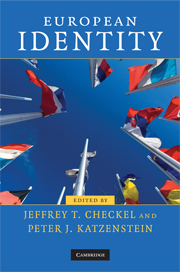Book contents
- Frontmatter
- Contents
- List of figures
- List of tables
- List of contributors
- Preface
- 1 The politicization of European identities
- Part I European identity as project
- 2 Political identity in a community of strangers
- 3 Experimental identities (after Maastricht)
- 4 The public sphere and the European Union's political identity
- Part II European identity as process
- Part III European identity in context
- Bibliography
- Index
3 - Experimental identities (after Maastricht)
Published online by Cambridge University Press: 05 June 2012
- Frontmatter
- Contents
- List of figures
- List of tables
- List of contributors
- Preface
- 1 The politicization of European identities
- Part I European identity as project
- 2 Political identity in a community of strangers
- 3 Experimental identities (after Maastricht)
- 4 The public sphere and the European Union's political identity
- Part II European identity as process
- Part III European identity in context
- Bibliography
- Index
Summary
The imperatives of European integration are inciting identity experiments, often involving dissonant and unstable forms of consciousness, that defy or exceed familiar categories of analysis. Rather than a mere shift in identity from, say, being German, Irish or Latvian to being European, a fundamental change in the underlying dynamics of identity formation is underway. Identities are coalescing on the level of intimate encounters, expressed in obscure and arcane cultural vernaculars, by which experience gains highly pluralist articulations posing unusual analytical challenges. Perhaps the most important challenge is to candidly acknowledge that “identity” has become, to a greater or lesser degree, an ambiguous and, at times, vexatious issue not just for us as observers, but also for our subjects (Boyer 2005). The people of Europe are at the outset of the twenty-first century negotiating among liberal and illiberal registers of consciousness, and these shifting configurations typically do not succumb to a single, stable, and unambiguous expression (see introduction to this volume).
I suggest in this chapter that what we awkwardly and imprecisely term “identity” has acquired a twofold nature. On the one hand, it is not merely or solely contingent on convention, tradition, and the past, but has assumed a future-oriented purview and experimental dynamic. On the other, citizens of the EU as they pursue these experiments are continually parsing the nature of cultural affinity and difference as they participate in the creation of a vast, multiracial and multicultural Europe.
- Type
- Chapter
- Information
- European Identity , pp. 52 - 80Publisher: Cambridge University PressPrint publication year: 2009
- 12
- Cited by



